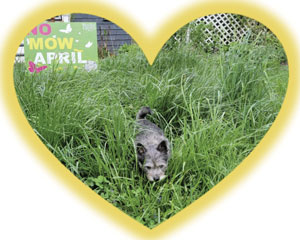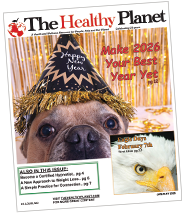
How Now, No Mow?
By Jean Ponzi
Gusts of debate, swirling through local suburbs, are seeding fertile dialogue around early spring suspension of lawn-height regulations, for a month of No Mow.
I caught wind of this because, on my job, I coach municipalities that do sustainability stuff. A couple of them were considering adopting No Mow April, as fielded in 2023 by the City of Webster Groves. What, I was asked, did I think about several articles linked to me — and about the No Mow idea overall?
Last year’s No Mow April happily surprised leaders of Webster’s Green Space and Sustainability Commissions: over 300 households snapped up all the project’s yard signs, and their social media convo was majority thumbs-up. With mere tweaks to their system — such as yard sign pick-up from a central source – Webster Groves is preparing now to field v2 of No Mow April.
Responding to those communities considering No Mow, I read up on turf-fan(atic) history, grass behavior, and expert intel on meeting pollinator needs.
What grew our love affair with lawns? 18th century swells in France and England boasted large expanses of lawn that said I’m so rich I can leave my land unproductive. They had staff (paid or indentured) to maintain it. Frederick Law Olmsted, co-designer of New York’s Central Park, packed this old-world baggage into his more enlightened views on ensuring nature access for the swelling urban American masses.
In our 20th century, post-War suburban communities — after Victory Garden urgency waned and Better Living Through Chemistry caught on — a manicured grass lawn became both a goal for personal happiness and a symbol of success.
Success? Achieved through weekly mowing chores or a lawn-service bill, water-use fees, and the costs and impacts of our arsenals of herbicide, pesticide, insecticide, and fertilizer chemicals. Success, I guess, is how you define it.
Turf-care professional sources are predictably anti-No Mow. They warn that long grass going to seed is a lawn death sentence. This is misleading about Poaceae, the grass family, where most turf species are self-seeding annuals. Do we not buy grass seed? Scaring us (“There will be rodents!”) can be countered by appreciating hawks and owls in our suburban neighborhoods. Turf alone cannot support lively, biodiverse food webs!
Pollinator advocates go more into the weeds, literally: Milkweed, Joe-Pye Weed and other habitat-restoring native plant species. At issue here is which plants are decent pollinator eats. Dandelions are hot-buttons, not because they spoil the Emerald Carpets, but because their pollen seems to be a poor source of bee protein, and a dandelion diet seems to cause bees to lose interest in finding better fare.
Some native plant champions forcefully challenge No Mow. Last year I had a spirited exchange with leaders of Grow Native! our outstanding regional ecological landscaping program. No Mow, they said, just perpetuates turf as the ideal. When shaggy turf gets whacked after four weeks of benign neglect, where are the native plants or any other pollinator food source? Our yards remain a desert for beneficial insects — while ticks and chiggers cheer and chew!
BEST practice for the cities I advise includes passing and supporting a Native Plant Ordinance, educating inspectors on what planted ecology looks like (compared to neighborhood neglect), why a wilder place is important, and proudly planting native examples right out on public grounds — plus mowing every other week, at most. No Mow is maybe, maybe not a part of this story.
NEXT BEST is encouraging plant diversity for areas kept in “lawn.” U of MN Extension has extensively researched Bee Lawn plants that tolerate foot traffic and mowing, ditch the chemical magic, and flower through all three growing seasons. These are plants like Dutch White Clover (Trifolium repens), Self-Heal (Prunella vulgaris), and Creeping Thyme (Thymus praecox). Here in MO, our Common Blue Violets (Viola sororia) enrich the pollinator menu, while being so lovely.
I am, frankly, firmly in favor of Turf Limits. I see lawns as high-maintenance living concrete, but an option for areas where the dog runs, where the kids play, and where you want to stroll past garden beds to biodiverse outdoor rooms.
I also see No Mow as E Pluribus Unum, one plausible path toward needed place-relations change: to transform human values and the quality of life for more-than-human communities, whose native-planted space we can share.
Jean Ponzi is an unabashed native plant advocate from the EarthWays Center of Missouri Botanical Garden. Hear many eco-logical conversations about all this from her Earthworms podcast, a long-serving feature of www.kdhx.org.


